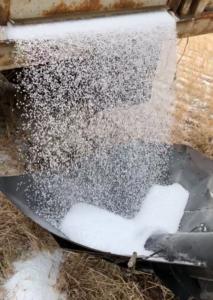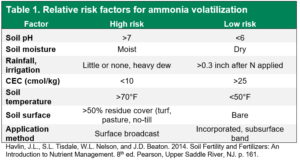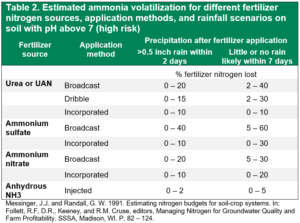Protect Nitrogen Fertilizer from Ammonia Volatilization
Recent rain and snow have brought much-needed precipitation to the northern Great Plains and upper Midwest regions. Some degree of drought conditions stretch from Alberta to Iowa, and agronomists and farmers are wondering the best ways to protect spring-applied nitrogen as the planting season continues. How much nitrogen might I lose if I cannot incorporate it? Does vertical tillage incorporate fertilizer enough? We have compiled some resources to help answer those questions.
There are three ways to lose fertilizer nitrogen: ammonia volatilization, denitrification, and nitrate leaching. In excessively wet soils, denitrification and nitrate leaching are a concern. However, for spring-applied nitrogen, ammonia volatilization is the main concern with dry soil conditions and unpredictable rainfall forecasts.
When you apply ammoniacal fertilizers (e.g. anhydrous ammonia, urea, UAN, ammonium sulfate) to the soil surface without sufficient incorporation, some amount of free ammonia (NH3) can escape to the atmosphere. Sufficient incorporation with tillage or precipitation is needed to safely protect that nitrogen investment below the soil surface. With dry soil conditions, this is important to remember because we must balance the need to protect nitrogen fertilizer while conserving soil water for seed germination and emergence.
Ammonia volatilization risk depends on soil and environmental factors (Table 1) and the nitrogen fertilizer source (Table 2). Typically, we are most concerned about ammonia volatilization for surface-applied urea or UAN. It is not easy to estimate how much nitrogen might be lost, and sometimes the losses can be substantial. Although you cannot change the soil type or weather forecast, you do have control over the nitrogen source and application method (Table 2) to protect your nitrogen investment.
Practices to reduce ammonia volatilization, in order of most effective:
- Apply urea in subsurface bands at least 3 inches below the soil surface. A shallow urea band (1 or 2 inches) acts like a slow-release anhydrous ammonia band, and nobody should ever apply anhydrous ammonia that shallow.
- If nitrogen will be broadcast with incorporation, make sure the fertilizer is sufficiently incorporated at least 2 inches below the soil surface to ensure good soil coverage. A chisel plow or field cultivator is usually needed. The popularity of high-speed disks (vertical tillage) has led some people to think that it counts as a meaningful incorporation event. In reality, it just moves soil and crop residue around on the soil surface without really incorporating any fertilizer. Take a look after you run across the field and you will see white urea granules everywhere. There are soil-applied herbicide incorporation videos from the 1970s that show what a thorough incorporation job really requires.
- If nitrogen will be broadcast without incorporation, try to time the fertilizer application right before rain (at least 0.3 inch of precipitation). Soils with good crop residue cover (no-till) may require more rain to sufficiently move urea or UAN into the soil surface.
- If no rain is forecasted in the near future, consider applying a urease inhibitor on urea or UAN to provide temporary protection until rain arrives. The university research-proven urease inhibitor is NBPT, available in products like Agrotain (Koch) and its generic cousins. For generic products, make sure the active ingredient rate is 1.3 to 1.8 lb NBPT per ton of urea to ensure effective NBPT activity and protection. NBPT begins to breakdown after 7 to 14 days. In addition, it is important to remember that nitrification inhibitors like nitrapyrin and DCD do not protect against ammonia volatilization.
These practices should also be considered if you will be applying in-season nitrogen to corn or wheat later in the summer. it is always best to apply nitrogen below the soil surface, such as injected anhydrous ammonia or coulter-injected UAN, to protect nitrogen fertilizer. For surface-applied urea or UAN, you will want to time the fertilizer application just before a rainfall or consider NBPT to extend the rainfall window.
Resources on ammonia volatilization and urease inhibitors
Nitrogen extenders and additives for field crops, NDSU
How long can NBPT-treated urea remain on the soil surface without loss?, NDSU
Should you add inhibitors to your sidedress nitrogen application?, University of Minnesota



